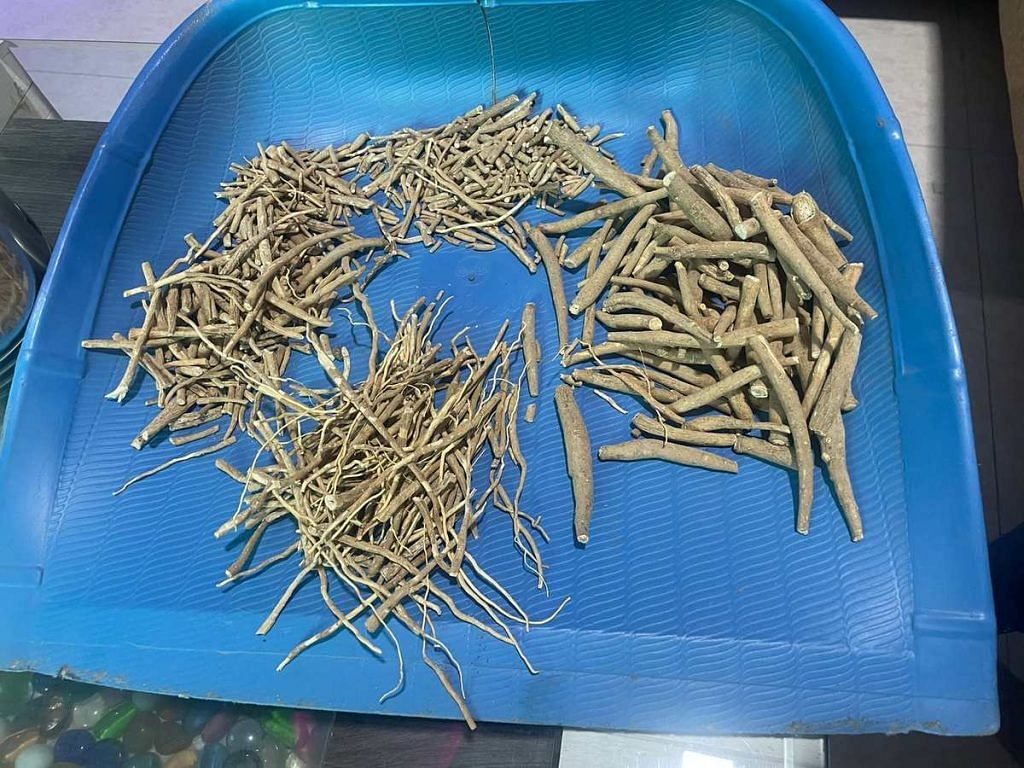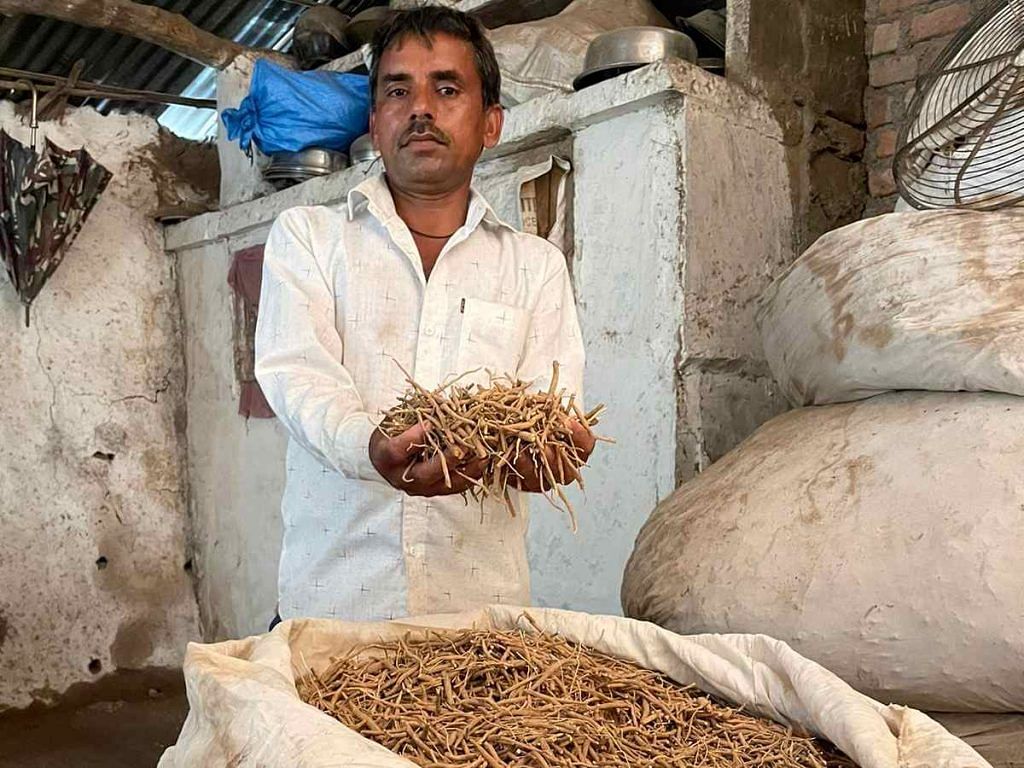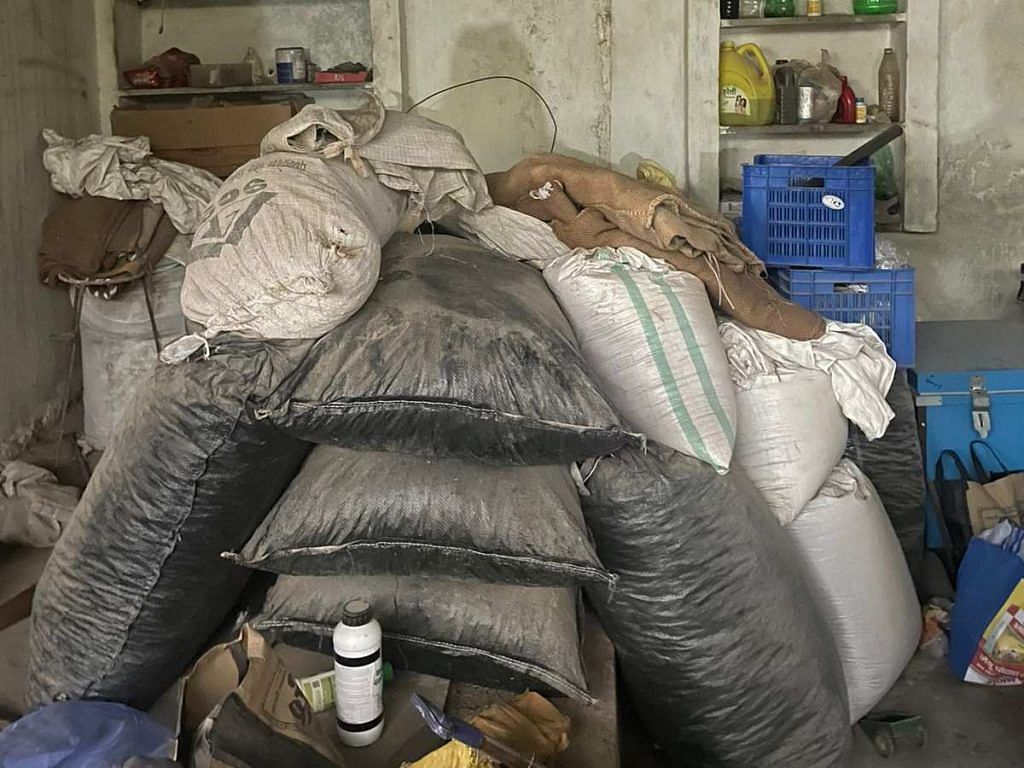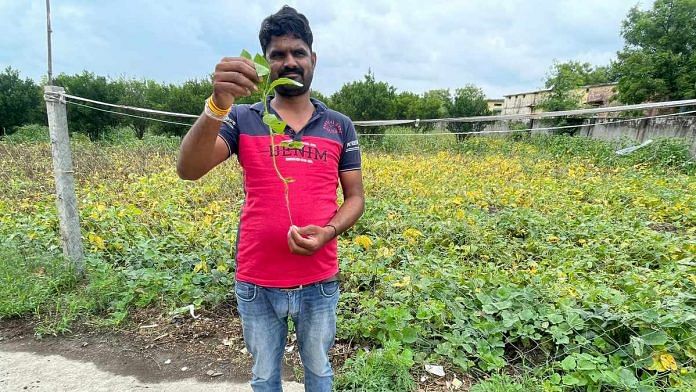Neemuch, MP: Almost every farmer in Madhya Pradesh’s Amlikheda village has a secure, locked room in the discreet corners of their homes. It’s not the family gold they are guarding. It’s sackfuls of the new global wonder herb ashwagandha.
And the Neemuch district is the epicentre of India’s ashwagandha gold rush.
Badri Lal, 43, has desisted from selling three quintals of ashwagandha roots since March 2023. Every morning, he checks the mandi rates on his smartphone, calls traders to negotiate, goes to his corner room, taps to check on the huge sacks of produce, and, with an air of confidence, gets back to bargaining with traders again.
There was even an ashwagandha heist in Neemuch last year. Twenty quintals of the herb, stored in a trader’s godown, were stolen. Headlines announcing “11 arrested for stealing Ashwagandha worth Rs 12 lakh; 4 accused still on the run,” spread in the villages.
“I won’t sell the crop produce till the right price is pitched,” said Lal with conviction.
In the Neemuch district, a new mini-green revolution has taken root since the Covid-19 pandemic spooked the world and immunity boosters became a buzzword in India and abroad.
Since the pandemic started, about a thousand farmers here have moved away from their traditional soybean and garlic crops and switched to ashwagandha. Many cashed in.
From Organic India to Himalaya to Natural Remedies, there is a race between brands to acquire more ashwagandha. Even Baba Ramdev’s Patanjali used the herb procured from Neemuch mandi for Coronil.
The lure of the crop is such that the Neemuch farmers started selling 1 kg of ashwagandha for Rs 500-600, well above the earlier going rate of Rs 100-150.
Expensive cars like Scorpios, Thars, and Hyundai i20s line the roads, and many farmers live in spacious two-storey bungalows with big courtyards and enclosures for cattle.
Called “Indian ginseng” across the world, ashwagandha from Neemuch mandi has reached markets in the Czech Republic, Canada, and the United States. It is the new king of Ayurveda.
India is the top producer and exporter of the herb, with Madhya Pradesh and Rajasthan leading the way, say officials at the Ayush ministry.
The markets, domestic and international, have been hungry for ashwagandha, used in Ayurvedic formulations to strengthen immunity, reduce stress, and increase stamina. Sales in the US alone spiked by 225 per cent in 2021 from the previous year, reaching $92 million dollars in 2021, the ministry has reported. From being 34th on the chart of top-selling herbs in the US in 2018, ashwagandha jumped to number 7 during Covid in 2021.
There is a lot of demand in the American market for the crop. Our prime market is in the US.
– Samrath Patidar, Organic India area manager
Now, official energy is being pumped into getting Neemuch ashwagandha a GI (geographical indication) tag. It’s exciting news for growers, as it will help them reach more international customers and get better prices.
“Ashwagandha is a miraculous crop for us. It has made farmers not only financially stable but allowed us to experiment with other crops and move away from traditional farming,” said Narendra Patidar from Janakpur village in Neemuch district’s Jawad block.
Also Read: Indians tried new-age Keto, Atkins, Paleo, low-carb. Now they’re going back to Ayurvedic diet
Big brands, expensive cars
Change has swept through Janakpur village in the past four years. Gone are the days of subsistence farming. Many farmers are now business-savvy, striking deals directly with big brands like Organic India, Jio Fresh, and Himalaya that flock here to buy ashwagandha.
The spoils are already visible. Expensive cars like Scorpios, Thars, and Hyundai i20s line the roads and many farmers live in spacious two-storey bungalows with big courtyards and enclosures for cattle.
But there are rumblings of discontent among some farmers. They want more and more, and quickly. They now become anxious if the prices plateau even for a bit.
Ashwagandha sales are higher now than they were pre-Covid but also not what they were at the peak of the pandemic. There are worries that with so many farmers jumping on the bandwagon, oversupply may start cooling the demand.
Many farmers are unhappy with mandi rates and said that they should be getting closer to the market price. They want to upgrade their i20s to Range Rovers.
Ashwagandha is described as balya (strength-giving), kamrupini (libido-enhancing), and pustida (nutritious) in ancient Ayurvedic texts like the Charaka Samhita.
Riding the ashwagandha wave
Farmers have been growing ashwagandha in Neemuch for four generations, well before it attained mass appeal. They swear by its virtues, which include balya (strength-giving), kamrupini (libido-enhancing), and pustida (nutritious) in ancient Ayurvedic texts like the Charaka Samhita.
Along the farmlands, villagers can often be spotted chewing on an ashwagandha root. Janakpur’s Narendra Patidar credited everything from his 101-year-old grandfather’s longevity to never contracting Covid to their daily habit of consuming the herb.
Patidar also praised ashwagandha for turning around his finances. He decided to ramp up his cultivation of the herb after a Krishi Vigyan Kendra seminar, organised by scientist Yatin Mehta who has worked in the district for 10 years.
These seminars happen every few months, and farmers receive notifications via WhatsApp. Patidar attended one in 2016, where he and other small-scale ashwagandha growers learned about the crop’s potential.
Black soil is best for ashwagandha and Neemuch has that. The ashwagandha roots that we get from other states often fail the quality test
-Kanhaiya Darak, trader
Inspired by the cultivators, Patidar shifted from growing it on half an acre to 5 acres. The results exceeded his expectations. He’s paid off all his debts, has a big house, and now owns 70 acres of land, dedicating 20 of them to ashwagandha cultivation.
Patidar’s top buyer is Organic India. Every year since 2018, the assistant area manager of the brand has visited Patidar during September’s cropping season to finalise a deal.
Last year, Patidar sold 350 quintals of ashwagandha to the company for Rs 25 lakh and has set the same target again.
Organic India area manager Samrath Patidar said that before the pandemic, the company would procure 150-200 quintals from the mandi, but now, customers’ appetite has shot up, especially in the US.
“There was a boom. In 2021, we purchased 55 MT (550 quintals),” Samrath Patidar explained. “There is a lot of demand in the American market for the crop. Our prime market is in the US,” he said.

For about 10 years, Organic India bought ashwagandha from the mandi but found that the quality was not up to expectations. The company started procuring directly from farmers in 2018 to ensure that it met high standards.
From sowing to harvesting, Samrath Patidar oversees every process to ensure that he gets the right variety and grade of ashwagandha.
It’s not just Organic India. Other big players like Himalaya, Sunflag Argotech, Jio Fresh, and Natural Remedies also procure ashwagandha directly from Neemuch farmers.
“At Neemuch mandi, we don’t get the right quality of ashwagandha. Plus, there are several taxes to pay. So, it’s good to directly procure the customised version from the farmers,” said an agent from Natural Remedies, which has been getting its supply directly from farmers since 2019.
Natural Remedies has consistently purchased 4,000 quintals directly from farmers for the past three years, this agent said.
The global ashwagandha extract market was valued at $864.3 million in 2021 and is projected to reach $2.5 billion by 2031.
This shift to direct procurement has catalysed around 500 farmers from various Neemuch villages, including Pipliya Raoji, Janakpur, and Bangred, to form a collective.
These farmers now have a WhatsApp group called ‘Organic Farmers’ where they discuss their produce, debate rates, and make plans for seed exchanges.
“Jordar maal hai (the produce is excellent),” boasted one farmer, sharing pictures of his ashwagandha bounty.
Another also touted his “high-quality” product. “I don’t want last year’s rates!” he wrote.
One member shared that he had stored his roots this season, but had sold 10 kg for Rs 5,000 last year.
Another farmer impatiently replied: “Talk about this year’s rates. How much do you want to sell for?”
Mandi woes
At the sprawling Neemuch mandi near the old railway station, the aroma of spices wafts through the air. The district administration claims that it is “Asia’s largest agriculture produce market yard”.
But the traders are having a hard time.
Dozens of them have gathered inside the Vyapari Sangathan (traders’ association) office, ribbing each other and airing their complaints.
They have several: The Covid frenzy for ashwagandha is fading, too many companies are going straight to farmers to avoid taxes, and the government isn’t doing enough to make the mandi a more attractive destination for exporters.
Veterinary companies in India and abroad used to buy ashwagandha extract. The real shift took place after Covid. Now, humans are also using it
-Mayank Jaiswal, trader
“Last year, a few buyers from the US had come to the mandi to buy ashwagandha but they cancelled their order and bought directly from the farmers,” a trader said, asking not to be named.
According to him, the poor conditions at the mandi were to blame.
“The buyers had cited unhygienic conditions at the mandi as the reason for their decision. The ashwagandha roots and powder were displayed on sacks laid out on the floor. There was dust on the produce and flies everywhere,” he added.

Another trader, also requesting anonymity, said more support was needed from the government.
“Even after being Asia’s biggest mandi, the government has failed to make it suitable for the international market. Plus, the central government has imposed a biodiversity tax on ashwagandha purchases — it is still considered as forest produce despite being grown on agricultural land,” he said.
Despite these troubles, traders acknowledge that business is still on track, though at a pace slower than that during the Covid boom.
‘Nothing like Neemuch ashwagandha’
Every March, people from all over the country arrive at the mandi to sell their farm-grown ashwagandha, but everybody in this district agrees that Neemuch ashwagandha is in a league of its own.
“Black soil is best for ashwagandha and Neemuch has that. The ashwagandha roots that we get from other states often fail the quality test,” said Kanhaiya Darak, 40, a third-generation ashwagandha trader.
Neemuch and Nagaur in Rajasthan are the top producers of ashwagandha, although it is also grown in Punjab, Haryana, Uttar Pradesh, Gujarat, and Maharashtra.
Darak claimed that his grandfather, Ratan Lal, traded ashwagandha in the 1970s at a mere Rs 2 per kg, while his father, Hanuman Prasad, sold it for Rs 15 per kg.
Today, Kanhaiya commands a price of Rs 300 per kg for the product. He also buys the roots from farmers at the mandi during auctions and processes them into various forms, including powder, at his godown.
According to the Ayush ministry, Neemuch and Rajasthan’s Nagaur district are the top producers of ashwagandha in India, although it is also grown in states such as Punjab, Haryana, Uttar Pradesh, Gujarat, and Maharashtra.
Over the last few years, ashwagandha production in the Neemuch district has increased substantially, although official statistics vary.
Data provided by Neemuch’s deputy director of horticulture shows that in 2018-19, the district yielded 884.8 MT (8,848 quintals) on 1,264 hectares, which rose to 1,190 MT (11,900 quintals) on 1,700 hectares in 2021-2022, and reached 1,519 MT (15,190 quintals) on 2,170 hectares in 2022-23.
But the Ayush ministry, citing trade statistics from Neemuch mandi, says that production rose from 29,532 quintals in 2020-21 to 67,207 quintals in 2022-23.
Traders in Neemuch claim that the market demand for their product is 50,000 to 100,000 quintals. According to them, about 20,000 quintals of this demand comes from pharma and Ayurvedic companies, most of which are based in Hyderabad.
Mayank Jaiswal, a trader who has been selling ashwagandha for over two decades, said that before the pandemic, veterinary companies were the top buyers of the crop.
“Veterinary companies in India and abroad used to buy ashwagandha extract as a remedy for animals. The real shift took place after Covid. Now, humans are also using it,” Jaiswal said.
He and other traders said that this change in the market was driven by the Narendra Modi government’s promotion of Ayurveda as well as the pandemic-induced rush for remedies worldwide.
Ashwagandha is sold for a huge amount to angrez desh (foreign countries), but farmers don’t get the same amount
-Surinder Singh Parwar, farmer
From 2015 to 2021, the Ayush ministry implemented the National Ayush Mission to promote market-driven cultivation of 140 medicinal plants, including ashwagandha, through state implementing agencies. In March 2023, it also launched the World Ashwagandha Council to create awareness about the benefits of the crop.
The global ashwagandha extract market was valued at $864.3 million in 2021, and is projected to reach $2.5 billion by 2031, growing at a CAGR of 11.4 per cent from 2022 to 2031, said Ayush secretary Rajesh Kotecha.
Now, the district horticulture department is hoping the next push will come from Neemuch ashwagandha finally getting its GI tag.
While the department had applied for the tag last year, it was rejected since there was not enough documentary evidence to show that the region specialised in the crop, a horticulture official said.
“We are currently compiling evidence and conducting research to support our next application,” she added.
Also Read: Who is challenging Ayurveda in today’s India? Meet Kerala doctor, Cyriac Abby Philips
Green gold price wars
The ashwagandha wave lifted some farmers to new heights, but others struggled to stay afloat.
For some farmers with small land holdings, experiments with ashwagandha were disastrous, mostly because the crop is highly labour-intensive during harvest.
Om Prakash from Revlidevli village in Neemuch used to grow ashwagandha on his two acres of land, but it proved to be unsustainable.
An acre of ashwagandha requires between 80 and 100 labourers to properly uproot and separate the roots and stem. He and his wife tried to do the work themselves, but it proved to be too demanding. They are now back to growing garlic and soybeans.
Even for successful ashwagandha farmers, a new problem has emerged — oversupply. Ashwagandha is now abundant, causing mandi prices to slide.
It’s a high-stakes battle of demand and supply, farmers and traders, market price and profit margins for this reborn green gold.
But some farmers refuse to settle.
In March, Bansi Lal and other farmers from Amlikheda village carried their ashwagandha produce to the Neemuch mandi, but when the right price was not offered after hours of negotiation, they lugged all of it back.
They’ve stored their produce in big plastic sacks and are waiting for the right moment. If packed properly, ashwagandha remains free from rot and can be stored worry-free for two to three years.

During Covid, ashwagandha sold for Rs 35,000 to Rs 55,000 per quintal, depending on quality, but now the mandi is offering Rs 25,000, Lal said, standing in front of huge sacks of the crop.
He said his grandparents used to grow ashwagandha on a small scale, but he stopped because there was no major market. “I started again with half an acre of land in 2019, and now I grow it on 5 acres of land,” Lal said.
Holding up an uprooted ashwagandha plant, Lal explained that no part of the plant goes to waste. The roots, stem, and leaves are all sold.
Earlier, he claimed, the leaves sold for Rs 300 per kg, but the going rate is currently Rs 3.
Now, with farmers stowing away their ashwagandha, it’s a high-stakes battle of demand and supply, farmers and traders, market price and profit margins for this reborn green gold.
In Umarkhed village, Surinder Singh Parwar, 35, has stashed away five quintals of last year’s Ashwagandha harvest and is currently planting another batch on his 2.5-acre plot.
He boasted that ashwagandha is good for sexual wellbeing as other farmers nearby chuckle. “Isn’t it?” he asks them with a smile.
In 2018, Parwar bought a Splendor bike from his first flush of ashwagandha earnings. A few years later, he upgraded to an i20. But he’s still not happy.
He knows the national and international market prices and says that farmers aren’t reaping their fair share of the rewards.
“Ashwagandha is sold for a huge amount to angrez desh (foreign countries), but farmers don’t get the same amount,” Parwar said.
He opened Google Assistant on his phone and spoke: “Ashwagandha ka international bhav batao (Show ashwagandha’s international price).”
“See,” he said, pointing at the dollar amount displayed on the screen.
(Edited by Asavari Singh)



